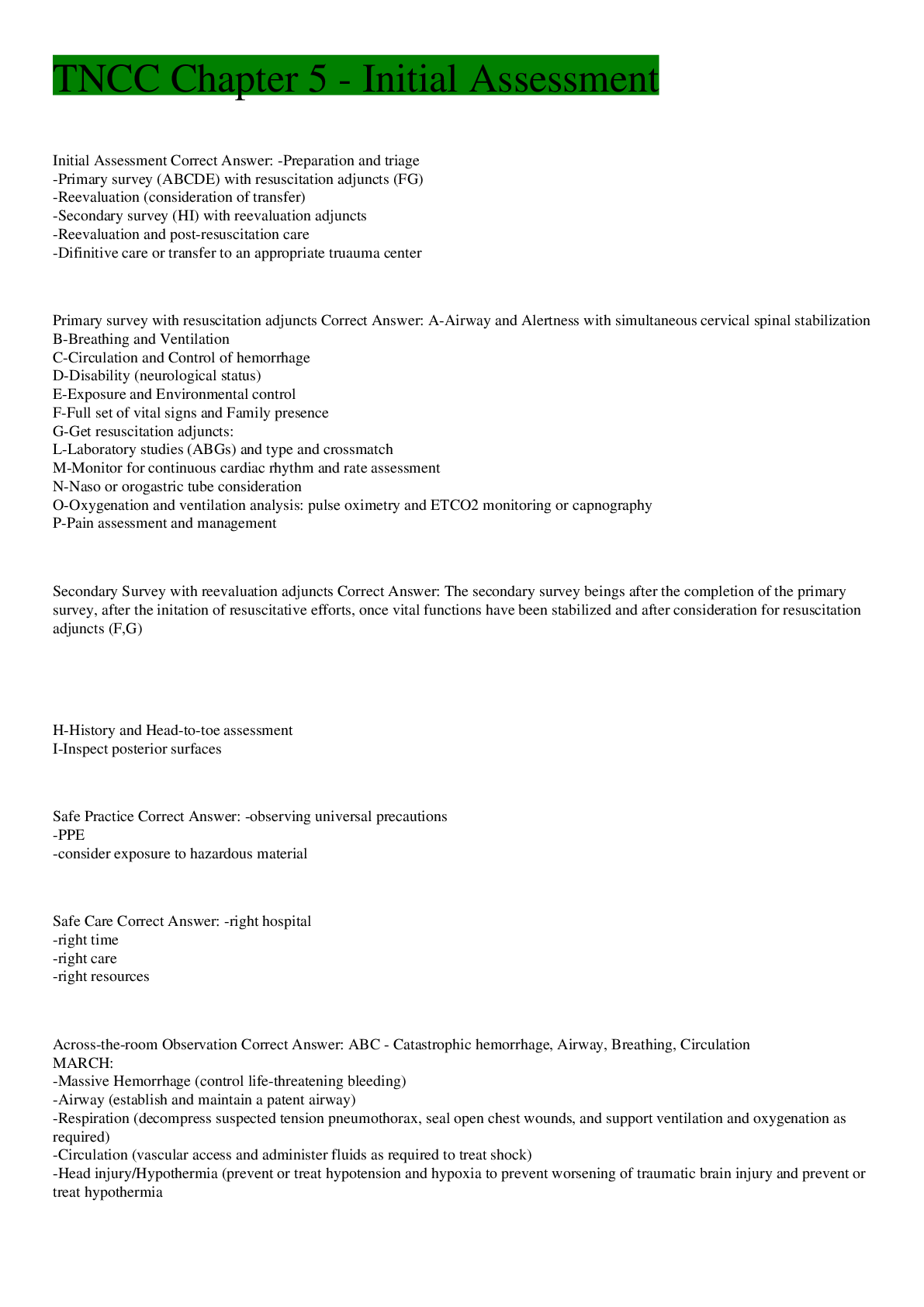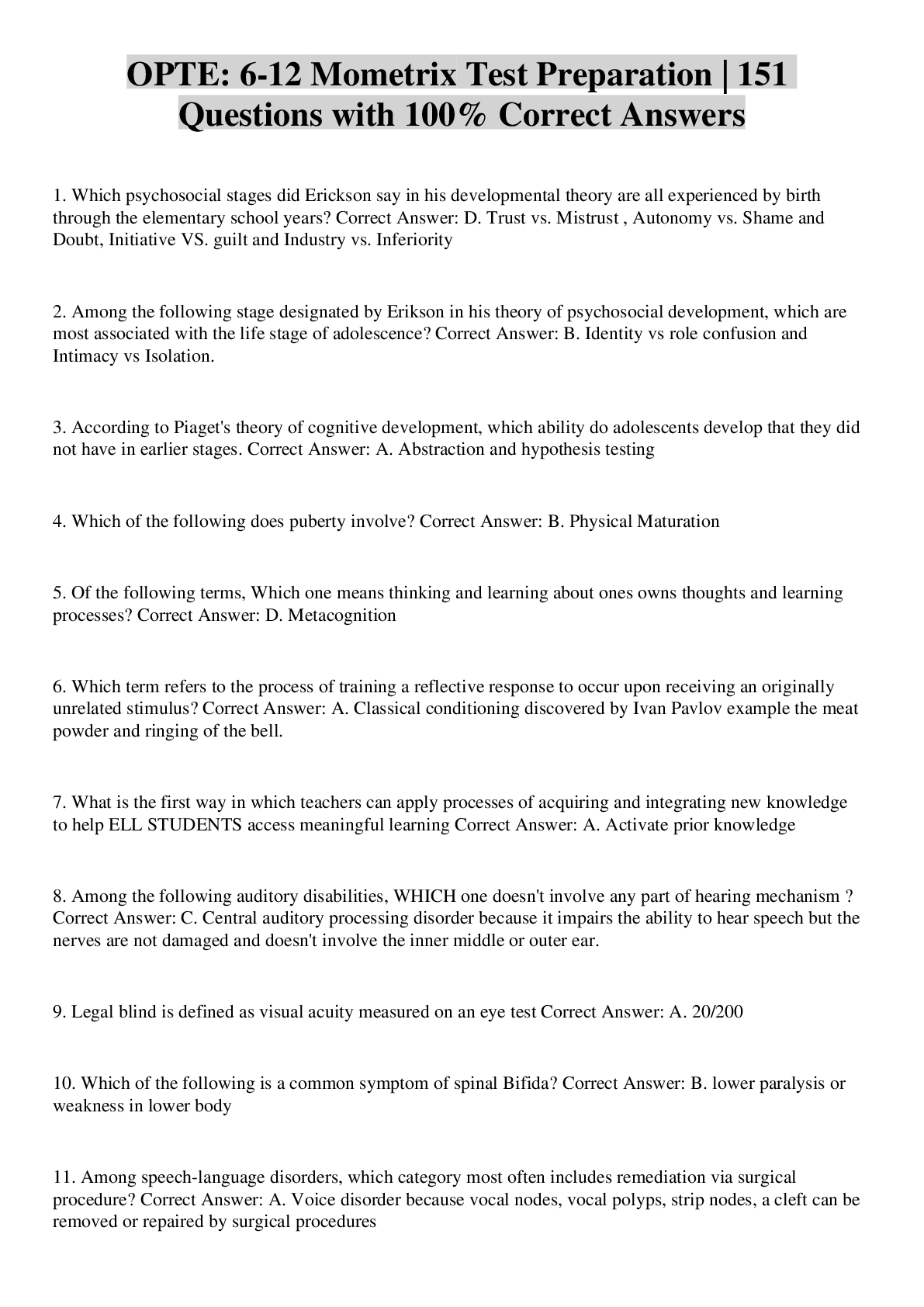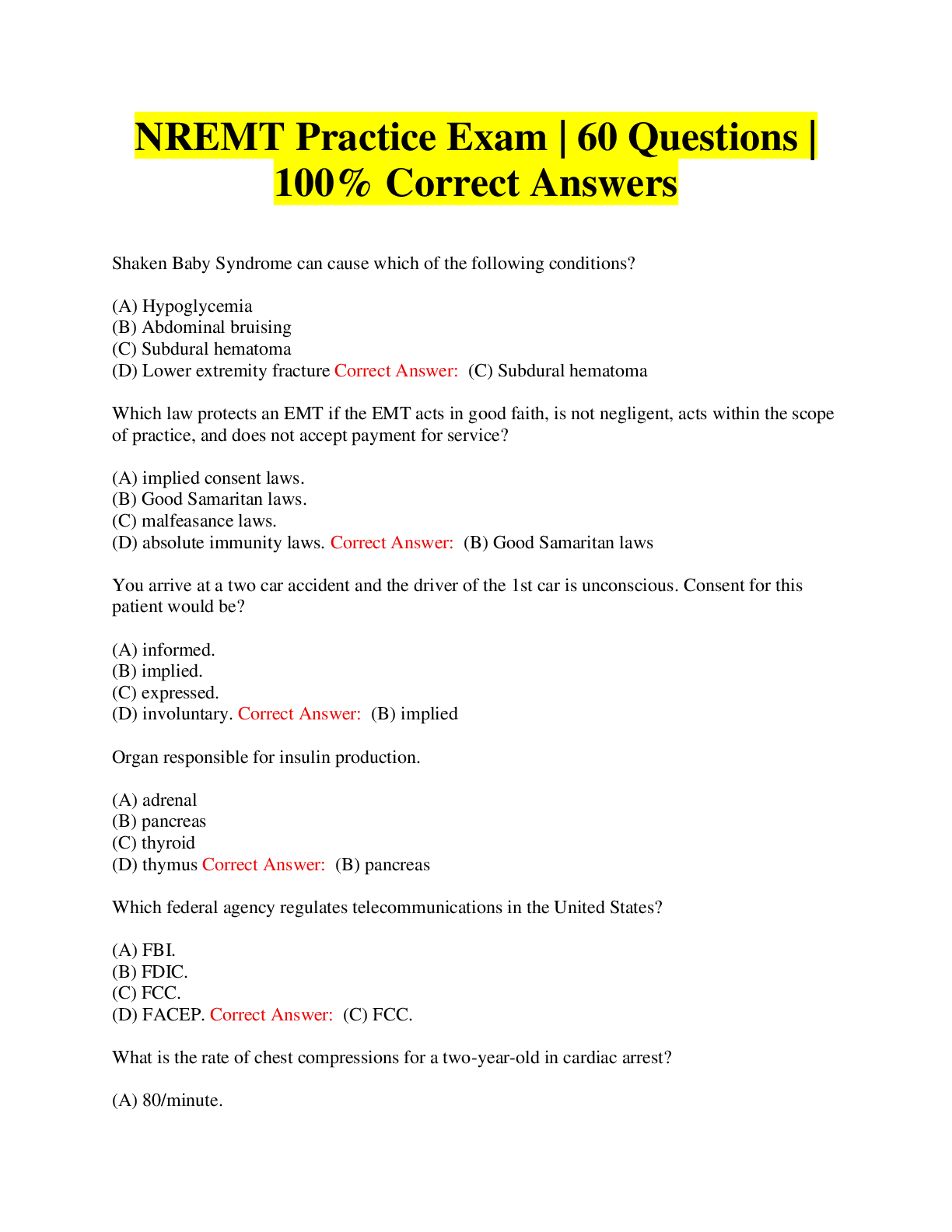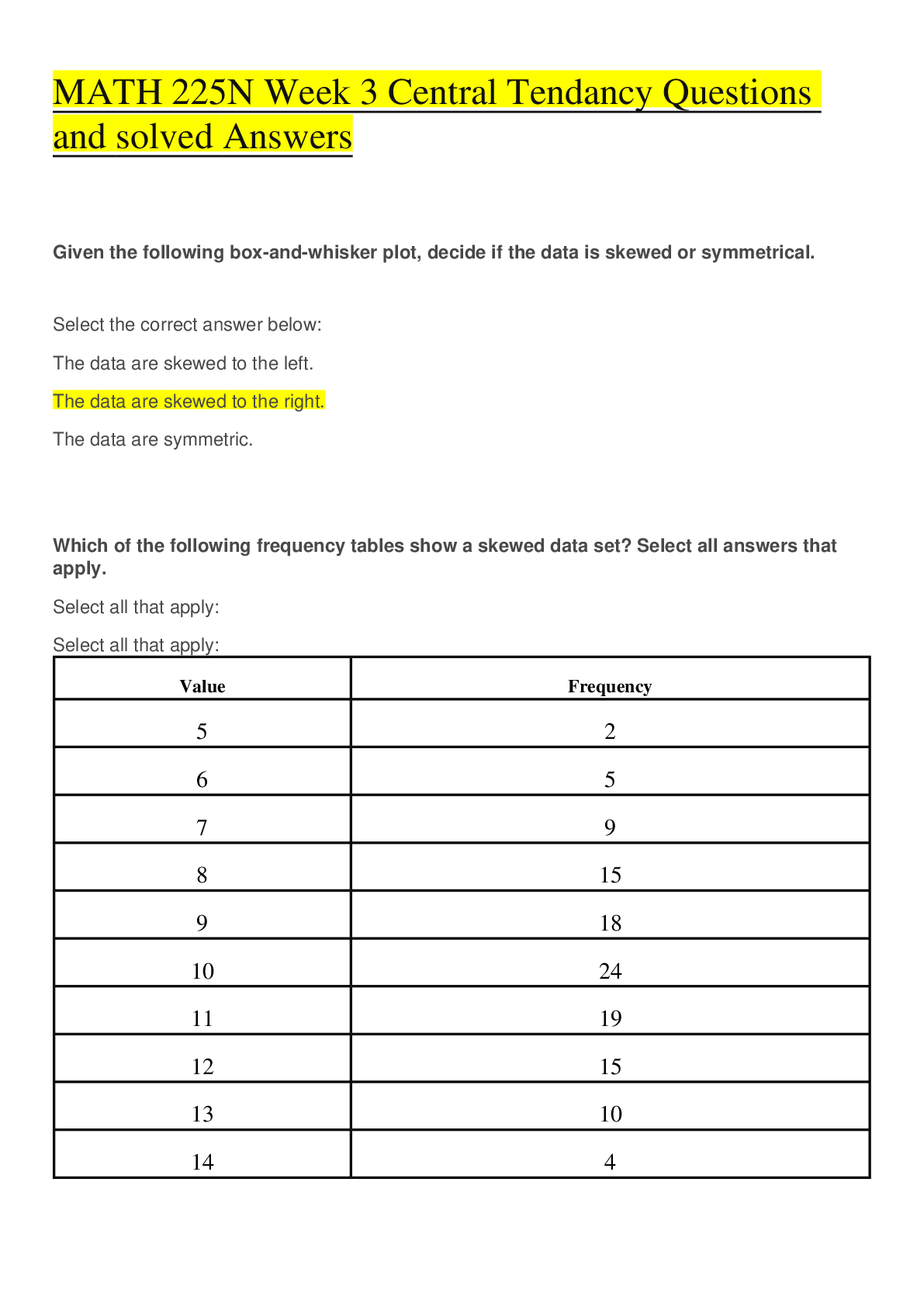Health Care > EXAM > TNCC Chapter 5 - Initial Assessment QUESTIONS AND ANSWERS 100% CORRECT (All)
TNCC Chapter 5 - Initial Assessment QUESTIONS AND ANSWERS 100% CORRECT
Document Content and Description Below
TNCC Chapter 5 - Initial Assessment Initial Assessment Correct Answer: -Preparation and triage -Primary survey (ABCDE) with resuscitation adjuncts (FG) -Reevaluation (consideration of transfer) ... -Secondary survey (HI) with reevaluation adjuncts -Reevaluation and post-resuscitation care -Difinitive care or transfer to an appropriate truauma center Primary survey with resuscitation adjuncts Correct Answer: A-Airway and Alertness with simultaneous cervical spinal stabilization B-Breathing and Ventilation C-Circulation and Control of hemorrhage D-Disability (neurological status) E-Exposure and Environmental control F-Full set of vital signs and Family presence G-Get resuscitation adjuncts: L-Laboratory studies (ABGs) and type and crossmatch M-Monitor for continuous cardiac rhythm and rate assessment N-Naso or orogastric tube consideration O-Oxygenation and ventilation analysis: pulse oximetry and ETCO2 monitoring or capnography P-Pain assessment and management Secondary Survey with reevaluation adjuncts Correct Answer: The secondary survey beings after the completion of the primary survey, after the initation of resuscitative efforts, once vital functions have been stabilized and after consideration for resuscitation adjuncts (F,G) H-History and Head-to-toe assessment I-Inspect posterior surfaces Safe Practice Correct Answer: -observing universal precautions -PPE -consider exposure to hazardous material Safe Care Correct Answer: -right hospital -right time -right care -right resources Across-the-room Observation Correct Answer: <C>ABC - Catastrophic hemorrhage, Airway, Breathing, Circulation MARCH: -Massive Hemorrhage (control life-threatening bleeding) -Airway (establish and maintain a patent airway) -Respiration (decompress suspected tension pneumothorax, seal open chest wounds, and support ventilation and oxygenation as required) -Circulation (vascular access and administer fluids as required to treat shock) -Head injury/Hypothermia (prevent or treat hypotension and hypoxia to prevent worsening of traumatic brain injury and prevent or treat hypothermia A-Airway and Alertness: CSI Correct Answer: -Cervical Spinal Immobilization (CSI) -until GCS of 15 and evaluation by xray/CT and physician -manual stabilization -immobilization -remove from spinal board as soon as spinal cord injury (SCI) is ruled out A-Airway and Alertness: Assessment Correct Answer: A-Alert. If the patient is alert, he or she will be able to maintain his or her airway once it is clear V-Verbal stimuli response. If the patient needs verbal stimulation to respond, an airway adjunct may be needed to keep the tongue from obstructing the airway P-Pain response. If the patient responds only to pain, he or she may not be able to maintain his or her airway, and an airway adjunct may need to be placed while a further assessment is made to determine the need for intubation U-Unresponsive. If the patient is unresponsive, check a pulse while assessing if the cause of the problem is the airway. Consider reprioritizing the assessment priority. <C>ABC A-Airway and Alertness: Inspect, Auscultate, and Palpate Correct Answer: -if unresponsive use jaw-thrust maneuver to open airway and can be used with CSI if performed by two providers. One providing manual stabilization and the other performs the jaw-thrust procedure -Inspect for tongue obstruction, loose or missing teeth, foreign objects, blood, vomit, secretions, edema, burns, inhalation injury -Auscultate for obstructive airway sondes such as snoring, gurgling or stridor -Palpate for possible occlusive maxillofacial body deformity, subcutaneous emphysema -with definitive airways look for proper placement. Presence of adequate rise and fall of the chest with assisted ventilation. The absence of gurgling on auscultation of the epigastrium. Bilateral breath sounds present on auscultation. Presence of carbon dioxide (CO2) verified by a CO2 detector device or monitor A-Airway and Alertness: Interventions Correct Answer: -Suction. Avoid stimulation gag reflex. Use a rigid suction device. Remove foreign body. -Airway Adjunct. use the jaw-thrust maneuver. Use nasophryneal. Use oropharyngeal airway on patients without gag reflex -Consider a definitive airway with apnea, GCS of 8 or less, severe maxillofacial fractures, inhalation injury or facial burns, laryngeal or tracheal injury or neck hematoma, high risk of aspiration, compromised or ineffective ventilation, anticipation of deterioration of neurologic status B-Breathing and Ventilation: Inspect, Auscultate, and Palpate Correct Answer: -Inspect for spontaneous breathing, symmetrical rise and fall of the chest, depth, pattern, rate, use of accessory muscles or diaphragmatic breathing, skin color, contusions, abrasions, deformities, open pneumothoraces (sucking chest wounds), Jugular venous distention (JVD) and the position of the trachea (late signs of tension pneumo), inhalation injury (singed nasal hairs, carbonaceous sputum) -Auscultate for presence, quality, and equality of breath sounds bilaterally at the second intercostal space midclavicular line and the bases at the fifth intercostal space at the anterior axillary line -Palpate for bony structures and possible rib fractures, subcutaneous emphysema (sign of pneumothorax), soft tissue injury, jugular venous pulsations at the suprasternal not or in the supraclavicluar area B-Breathing and Ventilation: Intervention Correct Answer: Use jaw-thrust manuver while maintaining C-Spine stabilization Can try airway adjunct (nonrebreather, nasal airway and assist with bag valve mask ETCO2 should be 35-45 mmHg, over 50 signals depressed ventialtion SpO2 should be >94% Pulmonary injuries requiring rapid identification and immediate intervention Correct Answer: Open pneumothorax: can be the result of a penetrating wound through the chest wall causing air to be trapped in the intraplural space. During inspiration air enters the pleural space through the wound, as well as through the trachea. Will hear sucking sound on inspiration and have subcutaneous emphysema. Completely cover open chest wounds with a nonporous dressing and tape securely on three sides. Monitor for tension pneumothorax. Tension pneumothorax: occurs when air enters the intrap [Show More]
Last updated: 2 years ago
Preview 1 out of 7 pages

Buy this document to get the full access instantly
Instant Download Access after purchase
Buy NowInstant download
We Accept:

Reviews( 0 )
$10.00
Can't find what you want? Try our AI powered Search
Document information
Connected school, study & course
About the document
Uploaded On
Sep 14, 2022
Number of pages
7
Written in
Additional information
This document has been written for:
Uploaded
Sep 14, 2022
Downloads
0
Views
41


























